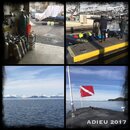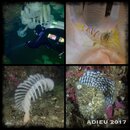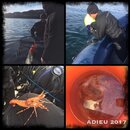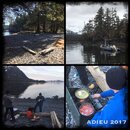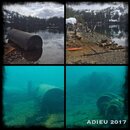A bit belated, but here's a post from my blog about one of our early season boat trips last month. Enjoy! 
PWS Opening Weekend
April is one of my favorite months on Prince William Sound. The days are getting longer, the temperatures are warming up, and it seems the weather is often favorable. Right around the middle of the month, an important date approaches - the opening of the PWS recreational shrimp season!
With shrimp pots and our dive/camping gear aboard, we joined the throng of boaters early Saturday morning and launched in Whittier. With a quick trip out Passage Canal in beautiful, calm water with the sun overhead, we crossed Port Wells and turned down Culross Passage. A humpback whale greeted us as we approached Applegate Island, where we unloaded our camping gear and established our campsite for the weekend.
After donning drysuits we headed south towards Herring Bay (Knight Island) to visit a dive site that we discovered last October, and one that is rapidly becoming one of my favorites in Alaska. We dropped the shrimp pots nearby to soak, then geared up and descended to visit "Porpoise Point."
As we slowly sank through the first 30 feet of water, I began to wonder if the poor visibility we've had closer to shore would continue out this far. When the bottom came into view at 50' all concerns were laid to rest and we were pleasantly surprised to learn that we had at least 60' of visibility. As we began to move away from our drop point I quickly spotted 3 sea pens and numerous lemon peel and clown nudibranchs. Heralds of a good dive! Always lots of life here.
We swam down a wide channel and towards the edge of the plateau, and as the bottom fell away a mountain of rock covered in thousands of white plumose anemones came into view. Dozens of rockfish hid in the cracks and we started looking for the predatory Lingcod, which always seem to be perched on the overhanging ledges, looking out for an easy meal. Finding none, we swam off to follow a narrow finger of rock that leads to another edge of the plateau. This site typically produces rare critter sightings, and as I moved a bit closer to inspect a crimson anemone I saw the distinctive red, yellow and blue bars of a candystripe shrimp. Unlike their much larger (and more eatable) cousins, the candystripe is less than 2" long and hides within the protective tendrils of its host anemone, immune to the nematocysts. Easily one of our most colorful creatures.
I snapped a couple dozen photos, then we finned back towards the pinnacle and took one of the shortcuts back to our starting point. Swimming through the 20' tall valley we soon approached a T intersection. Had we gone to the right, we would have exited the center of the rock structure and been on the edge of the anemone covered rock wall, descending down to 130' before it terminates in a sand and rock strewn bottom. With our bottom time running a bit short, we instead continued straight, went up the rock staircase, and ascended to the boat waiting for us at the surface.
Back aboard the boat, I basked in the sunshine as my buddies did another dive on this site. Once they had their fill and the gear was back aboard, we motored a couple of miles away to pick up our shrimp pots and discovered that pulling 2, 600' lead line shots with 12 pound shrimp pots attached is an excellent way to rewarm ourselves after a dive. We counted a total of 28 nicely sized shrimp between the two pots; enough for dinner and not terrible for a 3 hour soak. I'm just thankful we didn't get skunked!
With flat calm water in front of us, it was a quick and easy run across the Sound to our campsite at Applegate Island. As we approached we stopped to throw our pots back in for an overnight soak, then anchored the boat off the beach for the night. After a delicious dinner of boiled shrimp cooked in saltwater on the beach, we tucked into our sleeping bags and tents and caught some much needed rest.
The next morning began with a bit of a chill, but after a hot breakfast meal and pulling the shrimp pots again (only 5 spots this time), we were warm and ready to start another day of diving. Making a short run across Port Nellie Juan to McClure Bay, we dropped the shrimp pots a third and final time before anchoring up at Cannery Bay.
As its name suggests, Cannery Bay was home to a small fish processing operation, destroyed during the Good Friday Earthquake (and subsequent tsunami) in 1964. Visibility was good enough that as we motored past in 40' of water we could clearly see the bottom was strewn with rubble and ruins. With nearly 100' of vis, I spent some time adjusting my camera settings from their typical macro mode so I could attempt to capture some wide angle shots. Visibility is rarely this good in Alaska and the views were incredible!
After the three of us rotated through this site, we made a run back to the head of McClure Bay to check the pots. With 15 more spot prawns in hand, we returned to Applegate to pick up our cache of camping gear, loaded it into the boat, and made the 30 mile journey back to Whittier.
Springtime diving can be a lot of work, but it can also be very rewarding. This was definitely one of the weekends where the effort was well worth it!
PWS Opening Weekend
April is one of my favorite months on Prince William Sound. The days are getting longer, the temperatures are warming up, and it seems the weather is often favorable. Right around the middle of the month, an important date approaches - the opening of the PWS recreational shrimp season!
With shrimp pots and our dive/camping gear aboard, we joined the throng of boaters early Saturday morning and launched in Whittier. With a quick trip out Passage Canal in beautiful, calm water with the sun overhead, we crossed Port Wells and turned down Culross Passage. A humpback whale greeted us as we approached Applegate Island, where we unloaded our camping gear and established our campsite for the weekend.
After donning drysuits we headed south towards Herring Bay (Knight Island) to visit a dive site that we discovered last October, and one that is rapidly becoming one of my favorites in Alaska. We dropped the shrimp pots nearby to soak, then geared up and descended to visit "Porpoise Point."
As we slowly sank through the first 30 feet of water, I began to wonder if the poor visibility we've had closer to shore would continue out this far. When the bottom came into view at 50' all concerns were laid to rest and we were pleasantly surprised to learn that we had at least 60' of visibility. As we began to move away from our drop point I quickly spotted 3 sea pens and numerous lemon peel and clown nudibranchs. Heralds of a good dive! Always lots of life here.
We swam down a wide channel and towards the edge of the plateau, and as the bottom fell away a mountain of rock covered in thousands of white plumose anemones came into view. Dozens of rockfish hid in the cracks and we started looking for the predatory Lingcod, which always seem to be perched on the overhanging ledges, looking out for an easy meal. Finding none, we swam off to follow a narrow finger of rock that leads to another edge of the plateau. This site typically produces rare critter sightings, and as I moved a bit closer to inspect a crimson anemone I saw the distinctive red, yellow and blue bars of a candystripe shrimp. Unlike their much larger (and more eatable) cousins, the candystripe is less than 2" long and hides within the protective tendrils of its host anemone, immune to the nematocysts. Easily one of our most colorful creatures.
I snapped a couple dozen photos, then we finned back towards the pinnacle and took one of the shortcuts back to our starting point. Swimming through the 20' tall valley we soon approached a T intersection. Had we gone to the right, we would have exited the center of the rock structure and been on the edge of the anemone covered rock wall, descending down to 130' before it terminates in a sand and rock strewn bottom. With our bottom time running a bit short, we instead continued straight, went up the rock staircase, and ascended to the boat waiting for us at the surface.
Back aboard the boat, I basked in the sunshine as my buddies did another dive on this site. Once they had their fill and the gear was back aboard, we motored a couple of miles away to pick up our shrimp pots and discovered that pulling 2, 600' lead line shots with 12 pound shrimp pots attached is an excellent way to rewarm ourselves after a dive. We counted a total of 28 nicely sized shrimp between the two pots; enough for dinner and not terrible for a 3 hour soak. I'm just thankful we didn't get skunked!
With flat calm water in front of us, it was a quick and easy run across the Sound to our campsite at Applegate Island. As we approached we stopped to throw our pots back in for an overnight soak, then anchored the boat off the beach for the night. After a delicious dinner of boiled shrimp cooked in saltwater on the beach, we tucked into our sleeping bags and tents and caught some much needed rest.
The next morning began with a bit of a chill, but after a hot breakfast meal and pulling the shrimp pots again (only 5 spots this time), we were warm and ready to start another day of diving. Making a short run across Port Nellie Juan to McClure Bay, we dropped the shrimp pots a third and final time before anchoring up at Cannery Bay.
As its name suggests, Cannery Bay was home to a small fish processing operation, destroyed during the Good Friday Earthquake (and subsequent tsunami) in 1964. Visibility was good enough that as we motored past in 40' of water we could clearly see the bottom was strewn with rubble and ruins. With nearly 100' of vis, I spent some time adjusting my camera settings from their typical macro mode so I could attempt to capture some wide angle shots. Visibility is rarely this good in Alaska and the views were incredible!
After the three of us rotated through this site, we made a run back to the head of McClure Bay to check the pots. With 15 more spot prawns in hand, we returned to Applegate to pick up our cache of camping gear, loaded it into the boat, and made the 30 mile journey back to Whittier.
Springtime diving can be a lot of work, but it can also be very rewarding. This was definitely one of the weekends where the effort was well worth it!



